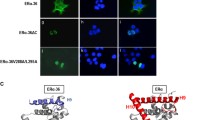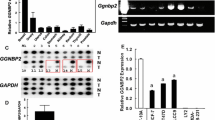Abstract
Estrogen receptor (ER) has been a successful target for effective prevention and treatment strategies in breast cancer, whereas growth factors and their signaling molecules are proving to be effective treatment targets as well. Understanding the interaction between ER and growth factor signaling pathways should provide clues to optimal treatment approaches and new strategies to overcome and prevent endocrine resistance. Cross-talk between ER and signal transducer and activator of transcription 5 (Stat5) has also been reported. Stat5 regulates growth, differentiation, and survival of mammary and hematopoietic cells. The role of Stat5 in breast cancer has not been established, although Stat5 is critical for some hematopoietic malignancies. We have analyzed the role of Stat5 in the progression of ER-positive breast cancer cells such as T47D and MCF7 in which Stat5b is constitutively activated. Adenoviral-mediated dominant-negative Stat5 induced apoptosis in T47D cells but not in caspase-3 negative MCF7 cells. Our study indicates that targeting Stat5 may represent a new strategy to suppress estrogen receptor activity and induce apoptosis in Stat5-activated, ER-positive breast cancer.
Similar content being viewed by others
Abbreviations
- Stat5:
-
Signal transducer and activator of transcription 5
- ER:
-
Estrogen receptor
- TK:
-
Tyrosine kinase
- PRL:
-
Prolactin
- PRLR:
-
Prolactin receptor
References
Osborne CK, Schiff R, Fuqua SA,et al: Estrogen receptor: current understanding of its activation and modulation.Clin Cancer Res 7: 4338s-4342s; discussion 4411s-4412s, 2001.
Hennighausen L, Robinson GW, Wagner KU,et al: Developing a mammary gland is a stat affair.J Mammary Gland Biol Neoplasia 2: 365–372, 1997.
Stoecklin E, Wissler M, Schaetzle D,et al: Interactions in the transcriptional regulation exerted by Stat5 and by members of the steroid hormone receptor family.J Steroid Biochem Mol Biol 69: 195–204, 1999.
Stocklin E, Wissler M, Gouilleux F,et al: Functional interactions between Stat5 and the glucocorticoid receptor.Nature 383: 726–728, 1996.
Bjornstrom L, Kilic E, Norman M,et al: Cross-talk between Stat5b and estrogen receptor-alpha and-beta in mammary epithelial cells.J Mol Endocrinol 27: 93–106, 2001.
Faulds MH, Pettersson K, Gustafsson Jk JA,et al: Cross-talk between ERs and signal transducer and activator of transcription 5 is E2 dependent and involves two functionally separate mechanisms.Mol Endocrinol 15: 1929–1940, 2001.
Saji S, Jensen EV, Nilsson S,et al: Estrogen receptors alpha and beta in the rodent mammary gland.Proc Natl Acad Sci USA 97: 337–342, 2000.
Bromberg J and Darnell JE Jr: The role of STATs in transcriptional control and their impact on cellular function.Oncogene 19: 2468–2473, 2000.
Grimley PM, Dong F, and Rui H: Stat5a and Stat5b: fraternal twins of signal transduction and transcriptional activation.Cytokine Growth Factor Rev 10: 131–157, 1999.
Yamashita H, Xu J, Erwin RA,et al: Differential control of the phosphorylation state of proline-juxtaposed serine residues Ser725 of Stat5a and Ser730 of Stat5b in prolactin-sensitive cells.J Biol Chem 273: 30218–30224, 1998.
Wakao H, Gouilleux F, and Groner B: Mammary gland factor (MGF) is a novel member of the cytokine regulated transcription factor gene family and confers the prolactin response.Embo J 13: 2182–2191, 1994.
Kazansky AV, Raught B, Lindsey SM,et al: Regulation of mammary gland factor/Stat5a during mammary gland development.Mol Endocrinol 9: 1598–1609, 1995.
Liu X, Robinson GW, Gouilleux F,et al: Cloning and expression of Stat5 and an additional homologue (Stat5b) involved in prolactin signal transduction in mouse mammary tissue.Proc Natl Acad Sci USA 92: 8831–8835, 1995.
Liu X, Robinson GW, Wagner KU,et al: Stat5a is mandatory for adult mammary gland development and lactogenesis.Genes Dev 11: 179–186, 1997.
Udy GB, Towers RP, Snell RG,et al: Requirement of STAT5b for sexual dimorphism of body growth rates and liver gene expression.Proc Natl Acad Sci USA 94: 7239–7244, 1997.
Socolovsky M, Fallon AE, Wang S,et al: Fetal anemia and apoptosis of red cell progenitors in Stat5a-/-5b-/-mice: a direct role for Stat5 in Bcl-X(L) induction.Cell 98: 181–191, 1999.
Hennighausen L and Robinson GW: Signaling pathways in mammary gland development.Dev Cell 1: 467–475, 2001.
Silberstein GB, Van Horn K, Shyamala G,et al: Essential role of endogenous estrogen in directly stimulating mammary growth demonstrated by implants containing pure antiestrogens.Endocrinology 134: 84–90, 1994.
Fendrick JL, Raafat AM, and Haslam SZ: Mammary gland growth and development from the postnatal period to postmenopause: ovarian steroid receptor ontogeny and regulation in the mouse.J Mammary Gland Biol Neoplasia 3: 7–22, 1998.
Binart N, Ormandy CJ, and Kelly PA: Mammary gland development and the prolactin receptor.Adv Exp Med Biol 480: 85–92, 2000.
Bocchinfuso WP, and Korach KS: Mammary gland development and tumorigenesis in estrogen receptor knockout mice.J Mammary Gland Biol Neoplasia 2: 323–334, 1997.
Krege JH, Hodgin JB, Couse JF,et al: Generation and reproductive phenotypes of mice lacking estrogen receptor beta.Proc Natl Acad Sci USA 95: 15677–15682, 1998.
Nowakowski BE and Maurer RA: Multiple Pit-1-binding sites facilitate estrogen responsiveness of the prolactin gene.Mol Endocrinol 8: 1742–1749, 1994.
Lydon JP, DeMayo FJ, Funk CR,et al: Mice lacking progesterone receptor exhibit pleiotropic reproductive abnormalities.Genes Dev 9: 2266–2278, 1995.
Ormandy CJ, Camus A, Barra J,et al: Null mutation of the prolactin receptor gene produces multiple reproductive defects in the mouse.Genes Dev 11: 167–178, 1997.
Horseman ND, Zhao W, Montecino-Rodriguez E,et al: Defective mammopoiesis, but normal hematopoiesis, in mice with a targeted disruption of the prolactin gene.Embo J 16: 6926–6935, 1997.
Sicinski P, Donaher JL, Parker SB,et al: Cyclin D1 provides a link between development and oncogenesis in the retina and breast.Cell 82: 621–630, 1995.
Yamashita H, Nevalainen MT, Xu J,et al: Role of serine phosphorylation of Stat5a in prolactin-stimulated beta-casein gene expression.Mol Cell Endocrinol 183: 151–163, 2001.
Favre-Young H, Dif F, Roussille F,et al: Cross-talk between signal transducer and activator of transcrip- tion (Stat5) and thyroid hormone receptor-beta 1 (TRbetal) signaling pathways.Mol Endocrinol 14: 1411–1424, 2000.
Frasor J, Park K, Byers M,et al: Differential roles for signal transducers and activators of transcription 5a and 5b in PRL stimulation of ERalpha and ERbeta transcription.Mol Endocrinol 15: 2172–2181, 2001.
Bowman T, Garcia R, Turkson J,et al: STATs in oncogenesis.Oncogene 19: 2474–2488, 2000.
Buettner R, Mora LB, and Jove R: Activated STAT signaling in human tumors provides novel molecular targets for therapeutic intervention.Clin Cancer Res 8: 945–954, 2002.
Ben-Neriah Y, Daley GQ, Mes-Masson AM,et al: The chronic myelogenous leukemia-specific P210 protein is the product of the bcr/abl hybrid gene.Science 233: 212–214, 1986.
Petersen H and Haldosen LA: EGF modulates expression of STAT5 in mammary epithelial cells.Exp Cell Res 243: 347–358, 1998.
Catlett-Falcone R, Dalton WS, and Jove R: STAT proteins as novel targets for cancer therapy. Signal transducer an activator of transcription.Curr Opin Oncol 11: 490–496, 1999.
Author information
Authors and Affiliations
Corresponding author
Additional information
Reprint requests to Hiroko Yamashita, Department of Surgery II, Nagoya City University Graduate School of Medical Sciences, Kawasumi 1, Mizuho-ku, Nagoya 467-8601, Japan.
About this article
Cite this article
Yamashita, H., Iwase, H. The role of stat5 in estrogen receptor-positive breast cancer. Breast Cancer 9, 312–318 (2002). https://doi.org/10.1007/BF02967610
Issue Date:
DOI: https://doi.org/10.1007/BF02967610




